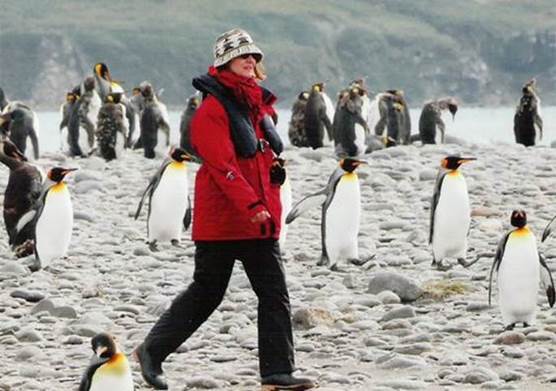
Friends:
As most of you know, Rita and I rarely go voluntarily to a cold climate. So the trip to Antarctica was not the norm. However, it turned out to be a memorable adventure and one of our favorite trips. Some photos are in the narrative below, but a bigger set of about 160 is at this link (click on the down arrow below first row of photos to expand).
Jan.30/31: Flew overnight to Santiago, Chile. We had the day in Santiago and did the natural thing for us – went to a winery about 45 minutes away. Which Chilean winery did we pick? Santa Rita of course.
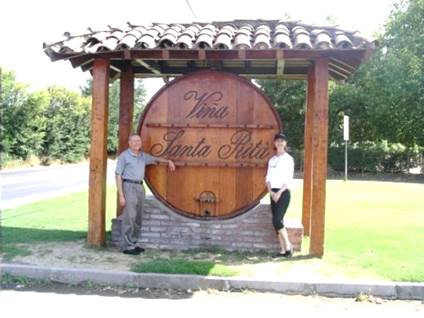
It was a beautiful setting, and we had a nice tour and wine tasting, followed by lunch in the famed Dona Paula Restaurant. The restaurant is named for the Chilean heroine who owned the estate and in 1814 sheltered 120 soldiers in the cellar after a battle with Spanish Crown soldiers. The well-known 120 wine brand of Santa Rita is named for those 120 patriots. That cellar is now used to store and age wines. On the way back to the hotel, we took a brief city tour.
Feb. 1: Flight from Santiago to Ushuaia, Argentina, on Tierra del Fuego. Almost all cruises to Antarctica are based out of Ushuaia, said to be the southernmost city in the world. We first went to a lunch with a gaucho-themed show and then to the ship to set sail out of the Beagle Channel toward the Southern Ocean. Our ship was the Explorer II, a sister ship to the Explorer that had sunk in Antarctica ice just two months earlier – all passengers and crew survived that misfortune. We joined 190 fellow passengers plus a large crew and a team of naturalists that provided daily talks. Each passenger was issued boots and a red parka.
Feb. 2: At sea with many sea-going birds constantly buzzing the ship, including various types of albatrosses, petrels and prions. The star is the wandering albatross which is the world’s largest flying bird (wingspan over 11 feet). With the aid of the updrafts from the waves, many of these birds fly for months and only land for annual breeding and feeding their chicks. Passengers with better eyes, timing and cameras were able to get some great close-up pics. We also got our first glimpse of whales in the distance. Lunch on the outside deck was a German barbecue and beer with the sun shining and temperature almost 50. February is summertime in Antarctica, mostly in the 30’s, but the wind determines the comfort level.
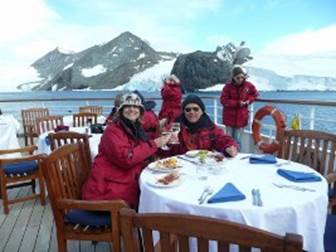
Feb. 3: Arrival in Port Stanley, Falkland Islands, known for the short 1982 war and several penguin colonies. This is the only stop where we disembarked at a dock – all other travel from the ship was by Zodiac raft. We first went to Bluff Cove Lagoon which has a large rookery of Gentoo penguins (about 1000 breeding pairs) plus a few King penguins. The chicks were in various phases of shedding their fleece and many were getting their first steps into the ocean.
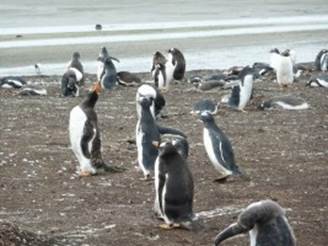
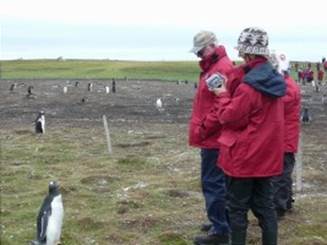
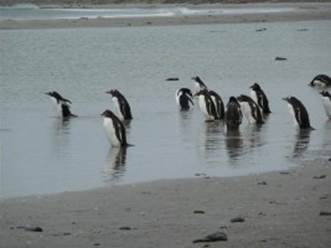
The rookery is located on a farm, and the family there also provides coffee and homemade cakes and cookies at the small Sea Cabbage Café. The men’s restroom is somewhat small, but a penguin sign alerts users to an alternative.
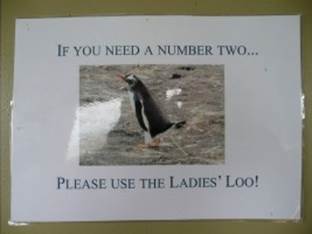
Our second stop in Port Stanley was Gypsy Cove, home to many Magellanic penguins that nest in the hillside rather than in the open in the manner of most other penguin species. Rita and I also saw Magellanic penguins in Galapagos in February of 2007. Gypsy Cove is one of many areas where parts are fenced off because of land mines left from the 1982 Argentinean invasion. This leaves the beach at Gypsy Cove to the penguins who are not heavy enough to set off the mines. With plenty of unused land in the Falklands, the locals have chosen to not continue removing the mines as that dangerous process was causing more serious injuries than leaving them in place. Note the pink coloring in the bay – this is krill, a small shrimp-like crustacean that forms in swarms of several million. Whales, seals and birds, including penguins, are highly dependent upon krill which is a dietary key to the ecosystem in the Southern Ocean. Pink krill leads to pink guano as will be seen later.
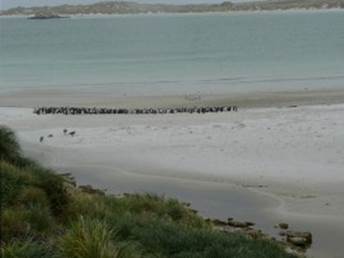
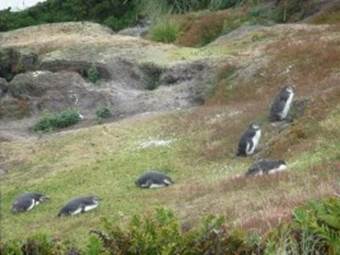
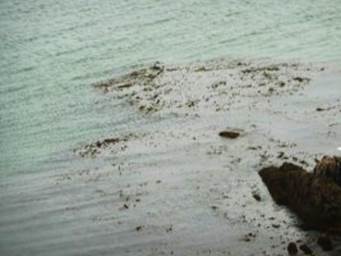

Feb. 4 and 5: At sea for about a 1000 miles east to get to South Georgia. I got this shot of an albatross checking out the ship. We also started seeing icebergs. When the icebergs first break off from glaciers, they are usually rectangular in shape. As they float into warmer waters, these “tabulars” melt below water and eventually become top-heavy and turn over to expose the bottom sides with many unusual shapes.
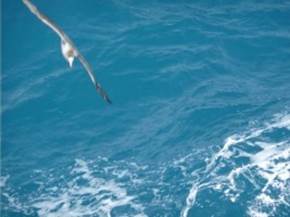

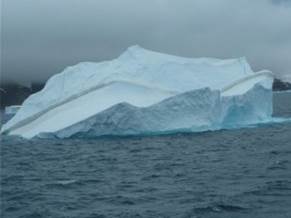
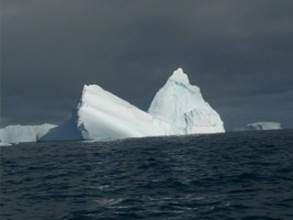
Whales were in abundance, mostly at a distance, but I saw a breach by a minke whale and Rita saw a humpback whale “fluke” – the tail slapping down as they dive. I think there were 6 species, but hard to spot all of them on different sides of the ship. The bridge on the ship will announce sightings with clock directions, such as “whale at 2:00”. The staff joke is about the passenger who asked if that was a.m. or p.m. We also got a valuable photo class on how to best use our digital point-and-shoot cameras. This also included how to protect them from the weather with ziplock bags – something that turned out to be an important lesson.
Feb. 6/7: South Georgia. First stop at Salisbury Plain is magnificent – an estimated 250,000 King penguins stretching from the beach up into the “Alps of the Southern Ocean”. The squawking/honking/whistling was unbelievable and Rita captured the sounds on her video camera shots. We simply could not stop taking pictures of these tuxedoed gems who seemed to be posing for us.
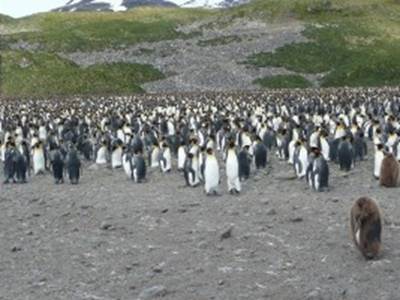
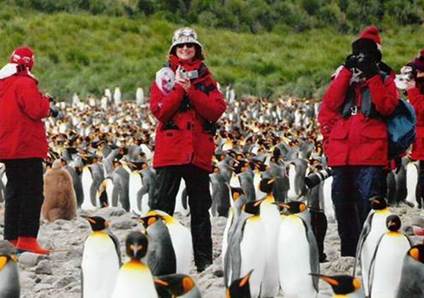
The Kings do not have a set annual time for breeding, and so there are all phases of penguin life – the juveniles with downy brown plumage (called “oakum boys”), adults molting (and hiding their shame at this in the mud pond) and parents incubating eggs on top of their feet under a stomach fold.
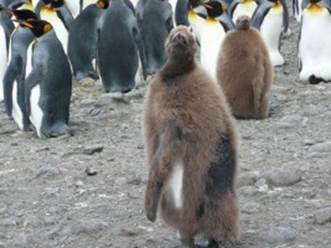
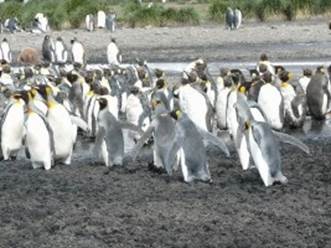
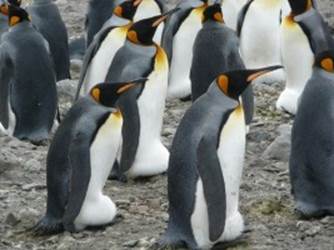
The Zodiac rafts each hold 10 passengers. Under rules established by treaty, only 100 passengers can come ashore at any one time, and so our shipload went ashore in two separate groups. In the long distance photo from the ship, don’t miss the red parka group among the penguins.
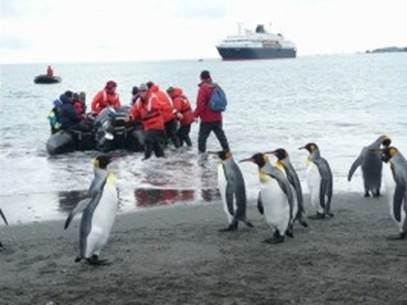
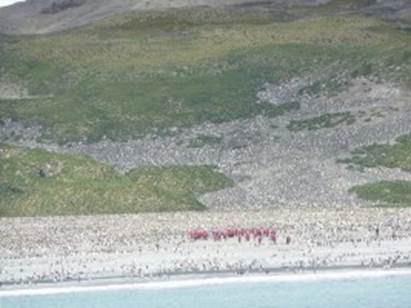
The next stop was Gryviken, an old whaling station where the famous explorer Ernest Shackleton is buried. Elephant seals and some King penguins congregate around the cemetery. A fur seal temporarily blocked Rita and some others. Shackleton’s story is a great one, and South Georgia played a major role as he came here to get a rescue ship for the men he left behind at Elephant Island. We had a champagne toast to “The Boss” and also saw a small local museum with Shackleton and whaling memorabilia.
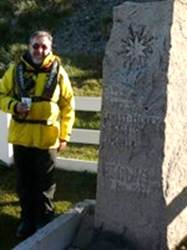
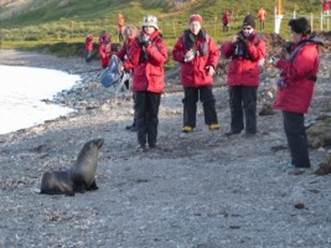
The second day in South Georgia was not so good. Part of the other group got to shore at the first stop at Gold Harbor, but the snow and waves hit and the stop was aborted. The snow was quite a surprise after the prior nice days. The passengers that did get out to Gold Harbor had to circle in the blowing snow until the ship was turned into the wind to reduce the swelling waves by the gangway for reboarding. We were glad be scheduled in the second group for this stop. As on Shackleton’s adventure, all survived. The weather also kept us from getting into Drygalski Fjord. Weather cancellations are not uncommon on Antarctica cruises and this is why fixed itineraries are generally not provided.
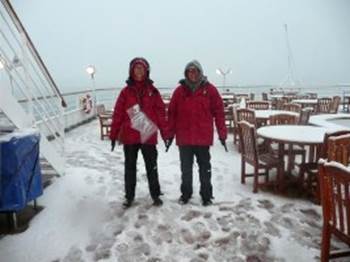
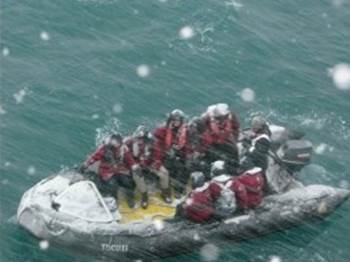
Feb. 8/9: Another 2 days at sea. Icebergs were now in abundance and we also got a great sunset reflecting colors off of the icebergs. By luck, I was taking a photo of one of the icebergs when it calved. Again, many seabird and whale sightings while at sea.
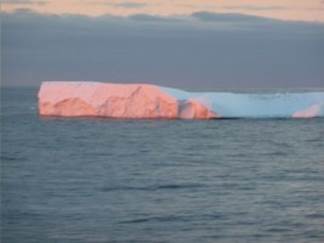
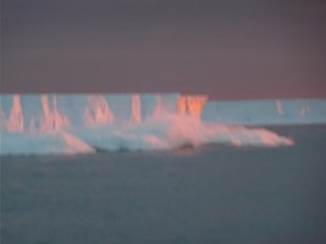
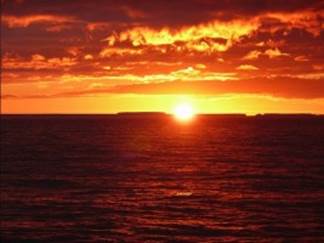
Feb. 10: We arrived at Elephant Island, and the first stop was Point Wild, another part of the Shackleton lore. Shackleton and his men had left their ship, the Endurance, that was trapped and sunk by the pack ice in the Weddell Sea. They lived on the ice for five months and then took three small boats to Elephant Island. Frank Wild was left in charge of 22 crew members for four winter months in 1916 – living under two of the small boats – while Shackleton left with five other crew members in a small boat to get help at South Georgia, 800 miles away. All of Shackleton’s crew members survived.
The primary residents of Elephant Island are the Chinstrap penguins, one of the four species that breed on the Antarctic Continent proper (the others being the Emperor, the Adelie and the Gentoo).
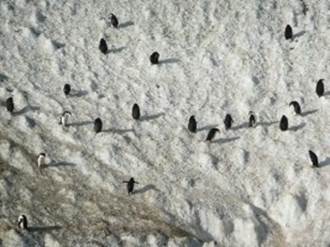
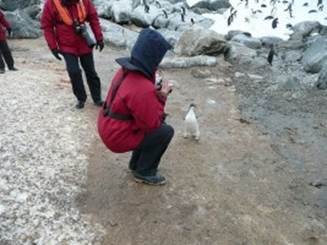
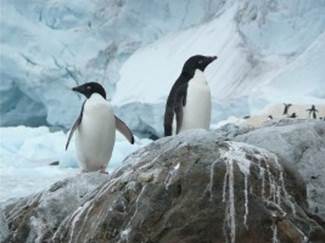
The night before this stop, one of the presentations from a naturalist described “leucistic” animals – all white skin/feathers – a mutation, but not albino since the eyes are not red. As we started our Zodiac ride around the rocks at Point Wild, one of the first things we saw was a leucistic Chinstrap penguin (below, the all-white one on the left). The staff joked that they carried this penguin on the ship to let out after they give the leucistic talk.
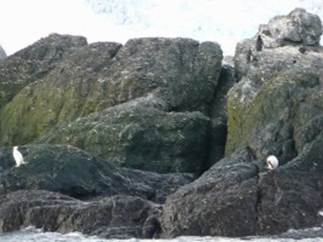
I got a bird trifecta photo with Chinstraps, a pale-faced sheathbill (the white bird, an eater of penguin guano) and a flying skua (a nasty predator, an eater of penguins). We got some great close-up views of “porpoising” penguins, although the photos are not well centered because of the rocking Zodiac.
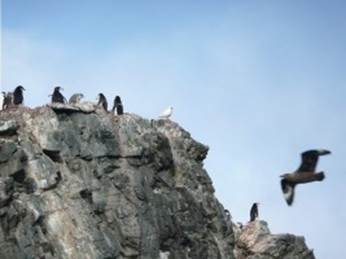
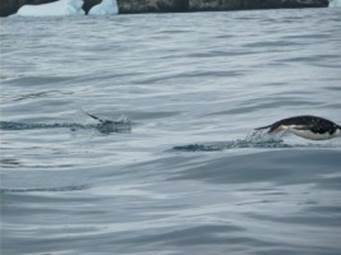
As we sailed out, we saw a mother/calf humpback whale pair and some major flocks of cape petrels (below). Later that day, a very active breaching humpback whale followed the ship for a long time. But no good whale photos by us.
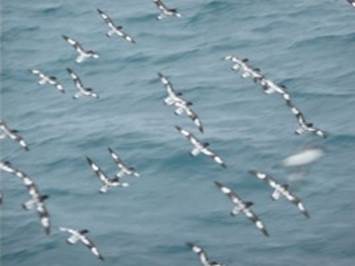
Feb. 11: Our first stop was to be Brown Bluff and be our only landing on the Antarctica Continent proper. Bad weather hit again with high waves and a lot of ice chunks blocking the beach. The captain made a call to the Argentinean base station close by and got permission to go to nearby Hope Bay where we were able to land and have a champagne toast while standing on the continent, as well as send greetings to four young grandchildren.

Hope Bay is home to thousands of Adelie penguins, and the young penguins were freshly molting and many were awkwardly approaching the water for their first dive into the sea. We took a Zodiac tour to view the Adelie-filled cliffs, glaciers and icebergs, and then returned to a barbecue on deck and music from the Explorer II Quartet. At the start the sun was out, but the weather changed suddenly and required gloves for the second glass of wine.
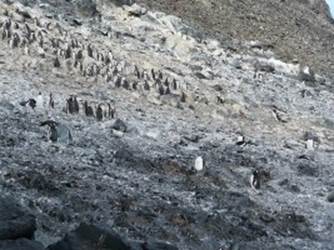
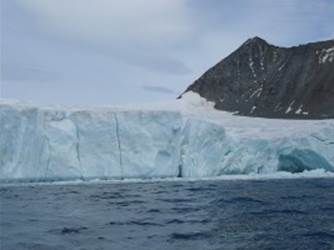
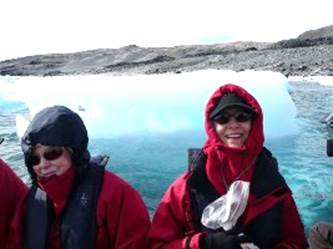
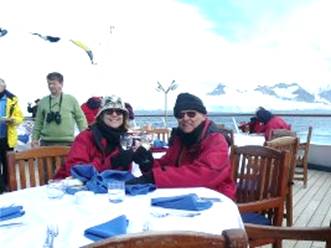
Our next stop was Madder Cliffs, a large hilly area populated by Adelies, as well as two of their predators: the skua and leopard seal. The snowy ground was streaked with pink guano to evidence the krill-filled diet. The young penguins huddle near the water on the ice, waiting to be pushed or voluntarily dive into the ocean for the first time.
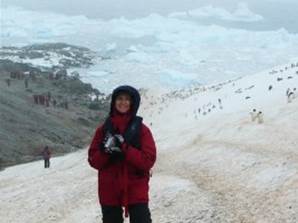
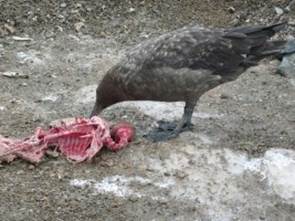
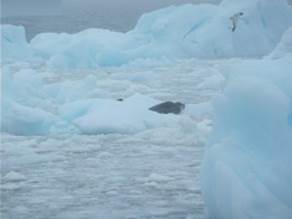
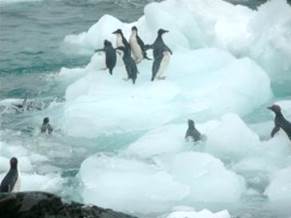
Feb. 12: The first stop of the day was Deception Island which is actually the caldera of an underwater volcano. When the top collapsed to form the caldera, a part fell below sea level allowing the caldera to be flooded. Ships are able to sail in through the opening (Neptune’s Bellows), and we took Zodiacs to shore on the interior lake. Some of us hiked to an area to view the ocean from the caldera interior (Neptune’s Window), while others took a swim in an area that often has hot springs warming the water – the participants advised that the hot springs were somewhere else that day. As we left through Neptune’s Bellows, it was nicely framed with a rainbow. The geology was reminiscent of Santorini in the Greek Isles where we had also sailed into a caldera on a cruise ship and tendered to shore – however, the people, climate and architecture of Santorini are much superior. Our favorite caldera is the Ngorongoro crater in Tanzania, a land based volcano with a caldera that holds a population of most major African mammals. We are apparently caldera groupies.
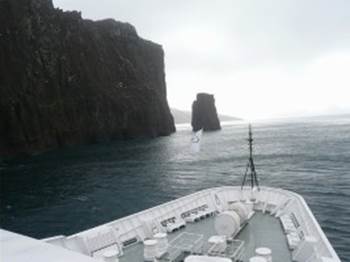
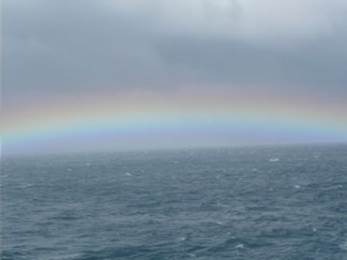
The second stop, and last excursion of the trip, was Yankee Harbor where we said our good-byes to the Gentoos and their seal friends. As we left on the Zodiacs, we cleaned our boots in the “Guanomatic”, a brush device to reduce any tracking of guano, germs, etc. to the ship or between the landing sites. The intent is to keep Antarctica pristine, and for the most part, that seems to be working.
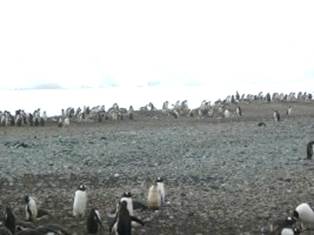
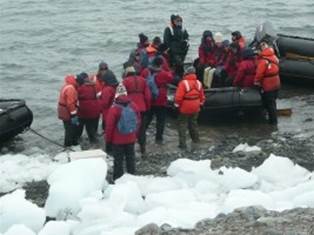
Feb. 13/14: We sailed through the Drake Passage where you either have the Drake Lake or the Drake Shake. The most common is the Shake, and that is what we got. Some discomfort, but not awful. Valentine’s Day brought a card from the crew with a heart-shaped iceberg.
Feb. 15/16: Arrival in Ushuaia, flight to Buenos Aires, overnight flight to DC and then home to KC.
Great trip.